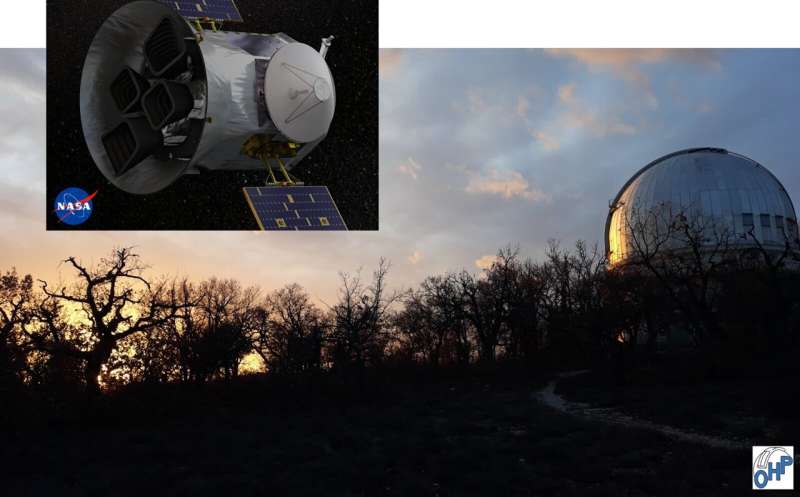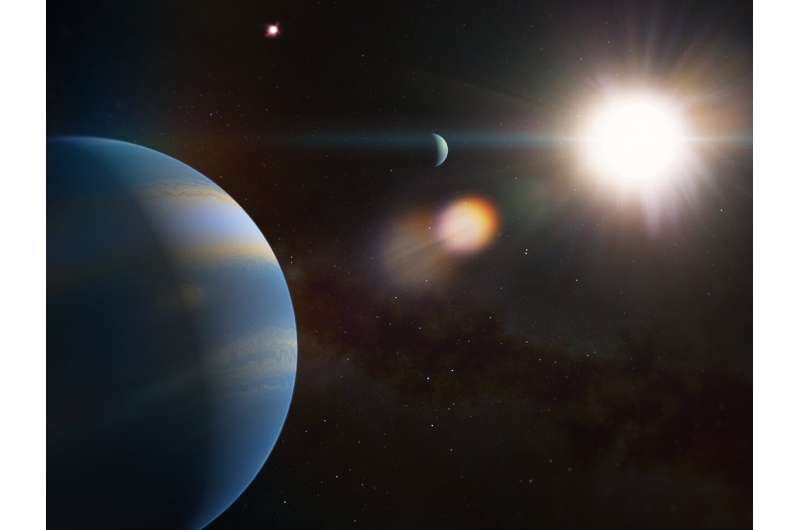This article has been reviewed according to Science X's editorial process and policies. Editors have highlighted the following attributes while ensuring the content's credibility:
fact-checked
peer-reviewed publication
proofread
Discovery of two planetary systems around sun-like stars

A study published today (Dec. 15) in the journal Astronomy & Astrophysics reveals the discovery of two new planetary systems orbiting stars similar to our sun, also known as solar analogs.
The study was led by Dr. Eder Martioli, a full researcher at the Laboratório Nacional de Astrofísica (LNA/MCTI) and an associate researcher at the Institut d'astrophysique de Paris (IAP), and by Dr. Guillaume Hébrard, a researcher at the Institut d'astrophysique de Paris (IAP).
Observations responsible for detecting these two systems, named TOI-1736 and TOI-2141, were conducted using NASA's TESS space telescope and the SOPHIE spectrograph installed on the 1.93 m telescope at the Observatoire de Haute-Provence (OHP) in southern France, both illustrated in Figure 1.
Planetary systems like these not only expand our understanding of the formation and evolution of planets around sun-like stars but also enable more precise measurements of the physical properties of these planets by leveraging the similarity between the host star and our sun.
Discovering exoplanets
The discovery of the first exoplanet around a sun-like star, 51 Pegasi b, in 1995, made using the same 1.93 m telescope at OHP and resulting in the Nobel Prize in Physics for astronomers Michel Mayor and Didier Queloz, marked the beginning of a revolution in our understanding of planetary systems in the universe.
Today, more than 5,500 exoplanets are known, and this count grows daily. The discovery of these objects offers an opportunity to study the occurrence of planets around stars and the variety of physical characteristics found in different systems.
One of the lessons learned since the discovery of the first exoplanet is that the solar system is not unique and does not encompass all possible types of planets. For instance, the planet 51 Pegasi b is Jupiter-sized but orbits much closer to its star than any other planet in the solar system, hence termed a "hot Jupiter." Other common types of planets in exoplanetary systems include super-Earths and mini-Neptunes, both absent in our solar system.
Another significant discovery is that a variety of stellar types, whether larger or smaller, hotter or cooler, do not prevent the formation of planets. However, the stellar type can influence the frequency of certain planet types.
The work by Dr. Eder Martioli's team focused on studying two stars very similar to the sun, each hosting a mini-Neptune and one of them also hosting a super-Jupiter. Neither type of these planets has a counterpart in the solar system. This allowed for a deeper understanding of the presence of planets with distinct characteristics and how these bodies evolve in an environment similar to our sun.
The planetary system TOI-2141
The first system in this discovery, TOI-2141, consists of a star located 250 light-years away, with a size nearly identical and a slightly more advanced age than our sun. Its chemical composition also reveals a scarcity of heavier elements compared to the sun. The quantity of these heavier elements is an important factor in the planetary formation process.
The planet TOI-2141b was detected using the transit method, where the planet passes in front of the star, causing small periodic eclipses enabling its detection by monitoring variations in the star's brightness. This planet has a diameter three times larger than Earth and a mass approximately 24 times that of Earth, classified as a mini-Neptune. It completes an orbit around the star every 18.26 days, maintaining a distance of only 13% of the distance between Earth and the sun.
Due to its proximity to the star, it's estimated the planet has a temperature of about 450°C. Its density suggests the presence of a rocky core and an atmosphere with a large amount of water, albeit solely in gaseous form due to the high temperatures. No other planets have been identified in this system, but the possibility of finding smaller planets cannot be ruled out due to the limitations of observation methods.

The planetary system TOI-1736
The second system of this discovery, TOI-1736, has revealed itself to be somewhat exotic. The main star is located at a distance of 290 light-years and is very similar to the sun, especially in terms of temperature and age, being only about 15% larger than the sun and having a slightly higher concentration of heavier chemical elements.
In this study, it was discovered that the TOI-1736 system has a companion star, smaller and cooler, thereby characterizing it as a binary star system. Nevertheless, the cooler star is sufficiently distant to avoid interference with the planetary system, which orbits exclusively around the primary sun-like star. At least two planets were detected in this system, as illustrated in Figure 2.
The first, TOI-1736b, is also a mini-Neptune, with a diameter 2.5 times larger than Earth and a mass 13 times greater than Earth's. It exhibits transits and orbits at a distance from the star equivalent to only 7% of the distance between Earth and the sun, completing an orbit every 7.1 days. Due to this proximity, the planet receives significantly more radiation from the star, resulting in an estimated temperature of 800°C.
The second planet, TOI-1736c, does not show transits, and it has a mass 2,800 times greater than that of Earth, nearly nine times larger than Jupiter—the largest planet in the solar system. With this size, TOI-1736c is classified as a super-Jupiter and narrowly missed becoming a star.
It completes an orbit every 570 days. Located just 30% farther away than Earth is from the sun, this planet is situated in the so-called habitable zone of the star TOI-1736. This zone is defined as the region around the star with a suitable temperature to allow for the existence of liquid water on the planet's surface.
TOI-1736c is likely a gas giant, similar to Jupiter, so it is not expected to have a solid surface like Earth's. However, if by chance the planet TOI-1736c hosts a moon, such a solid body might have an atmosphere, potentially enabling the presence of liquid water and, perhaps, being a habitable world.
Observations of TOI-1736 revealed indications of a possible third planet orbiting at a greater distance, requiring long-term monitoring for confirmation. Therefore, the team continues to observe TOI-1736 with the SOPHIE spectrograph at the OHP, hoping to soon gather more information about this star, so similar to the sun but hosting such a diverse planetary system.
More information: E. Martioli et al, TOI-1736 and TOI-2141: Two systems including sub-Neptunes around solar analogs revealed by TESS and SOPHIE, Astronomy & Astrophysics (2023). DOI: 10.1051/0004-6361/202347744
Journal information: Astronomy & Astrophysics
Provided by Laboratório Nacional de Astrofísica - LNA




















